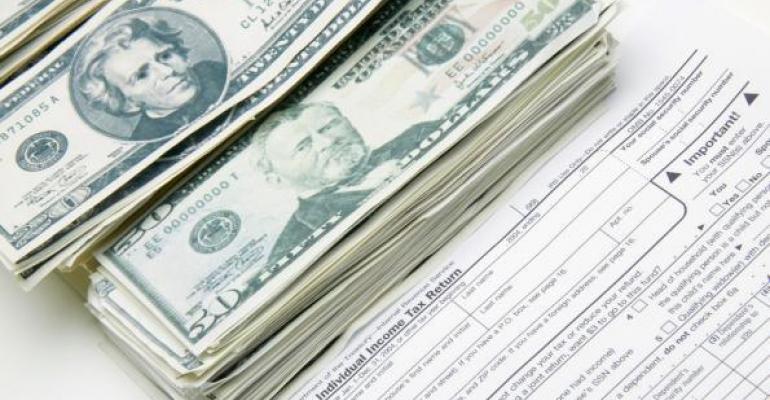(Bloomberg) -- What’s worse than watching your mutual fund investments decline in value? Getting hit with a big tax bill too.
That’s the reality some Americans are facing this year as the deadline to file taxes approaches. It’s largely a function of how actively managed mutual funds operate: Portfolio managers buy and sell securities within the fund to reposition their strategies, and many did so in 2022’s volatile market.
After a years-long bull market, many stocks in mutual funds had increased in value since they were purchased, despite the S&P 500’s 19% drop last year. That means they were subject to capital gains taxes when they’re sold. Those taxes are passed onto the fund’s holders, who have to pay even if they only bought into the fund recently.
“It’s the double whammy,” said Ben Johnson, head of client solutions for asset management at Morningstar. “Those taxable capital gains distributions are never pleasant, but in 2022 they feel like salt in the wound.”
Another factor is outflows from mutual funds. When investors decide to take their money out, the fund manager has to raise cash for the redemptions by selling securities, therefore triggering more capital gains. Mutual funds faced about $1 trillion in outflows last year, as many investors gravitated toward exchange-traded funds which are known for being more tax efficient.
“I think the long-term trend of negative net flows for many funds, especially actively managed mutual funds, is going to make this one-two punch more commonplace for mutual fund investors going forward, as redemptions can force a manager to sell appreciated holdings that they otherwise may not have sold,” said Chris Diodato, founder of WELLth Financial Planning in Palm Beach Gardens, Florida.
The Math
The capital gains distribution on a mutual fund is expressed as a percentage of its net asset value (NAV), which is the fund’s assets minus its liabilities divided by the number of shares outstanding. The bill is proportionate to how many shares you own: Consider an investor with 1,000 shares of a mutual fund with a net asset value of $30. If the capital gains distribution is 10% of the NAV, the investor would have a capital gain of $3 per share, or $3,000 in total.
That $3,000 is then taxed at the long-term capital gains rate, depending on income. Single individuals with an income between $0 to $41,675 pay nothing, while those who make $41,676 to $459,750 pay 15% and those with income above $459,750 pay 20%. So for someone in the middle bracket, the bill would come to 15% of $3,000, or $450.
Of course, this is only the case for mutual funds in taxable accounts. Retirement accounts like 401(k)s won’t face capital gains bills.
While it’s impossible to know exactly what fund managers sold to incur capital gains, many were exposed to tech stocks that surged for years before dropping sharply in 2022.
For those who plan to buy shares of mutual funds, check the record date, or the date by which investors have to own the fund in order to get capital gain distributions. Most funds pay out capital gains toward the end of the year, and the last thing you want is to get hit with a tax bill right after buying into a fund for the first time.
The Funds
Here are the funds with the largest capital gains distributions last year, according to data from Morningstar and Bloomberg:
Bruce Fund (BRUFX)
Inception date: 3/20/1968
Capital gain in 2022: 58.7%
This fund invests in domestic stocks and bonds, along with zero-coupon government bonds. It currently has about $505 million in assets, and its price declined 20% last year. With a current NAV of $520, an investor with 10 shares worth would have a capital gains bill of about $3,100 to then pay taxes on.
State Street Small/Mid Cap Equity Index Fund (SSMKX)
Inception date: 8/12/2015
Capital gain in 2022: 33.1%
With $391 million in assets, this fund holds small- to mid-cap US equities, including Blackstone Inc., Airbnb Inc. and Workday Inc. It lost 27% in value last year.
SEI Institutional Investments Trust Large Cap Index Fund (LCIAX)
Inception date: 4/1/2002
Capital gain in 2022: 24.1%
This $1.6 billion fund’s objective is to invest in the securities of the 1,000 largest US companies. Its largest holdings are Apple Inc., Microsoft Corp. and Amazon.com Inc., and its price dropped 31% in 2022.
Delaware Ivy Global Growth Fund (IVINX)
Inception date: 4/30/1986
Capital gain in 2022: 21.5%
The Delaware Ivy Global Growth Fund has about $522 million in assets, and invests in equities primarily traded in European, Pacific Basin and Latin American markets. Its price fell 53% last year.
DWS Equity 500 Index Fund (BTIIX)
Inception date: 12/31/1992
Capital gain in 2022: 19.7%
This fund’s goal is to provide a low-cost way for investors to get exposure to the S&P 500 companies, with Apple Inc. and Microsoft Corp. as its largest holdings. It has about $460 million in assets and declined 29% last year.
Rydex Nova Fund (RYNVX)
Inception date: 7/12/1993
Capital gain in 2022: 18.3%
There’s an unusual twist to this fund: The goal is to return 150% of the daily performance of the S&P 500, using leveraged derivative instruments. That strategy resulted in a 43% drop last year.
State Street Hedged International Developed Equity Index Fund (SSHQX)
Inception date: 5/29/2015
Capital gain in 2022: 17.9%
This $3.8 billion fund aims to reflect the performance of large and mid-cap equities in developed markets, excluding the US, but hedged to the US dollar. It lost 22% last year.
To contact the author of this story:
Claire Ballentine in New York at [email protected]





